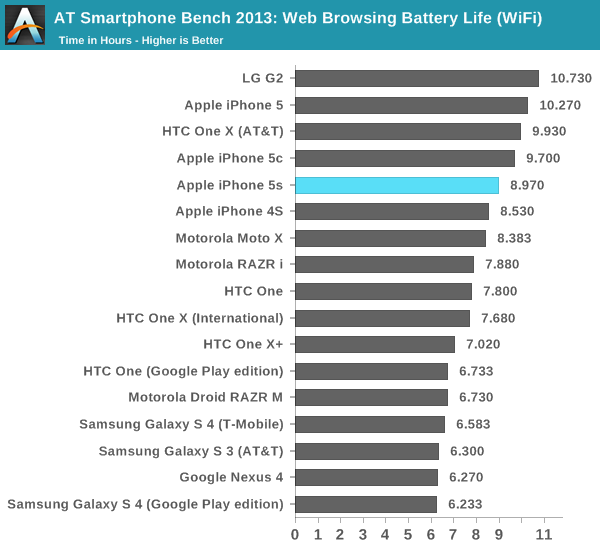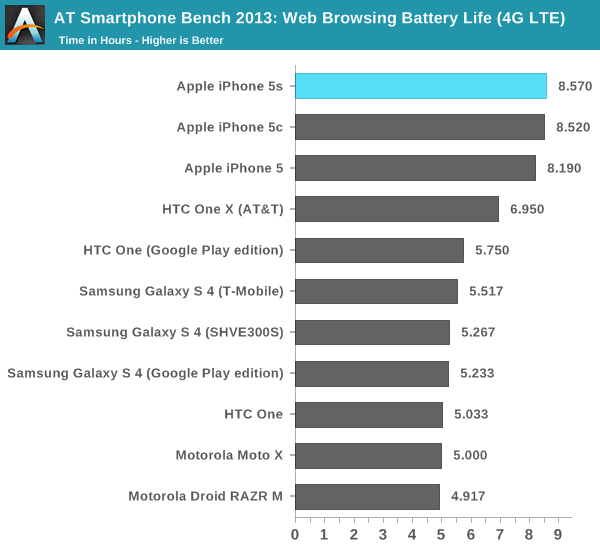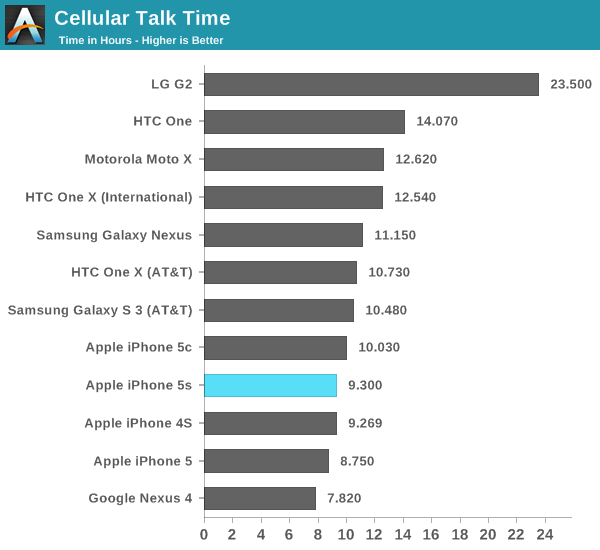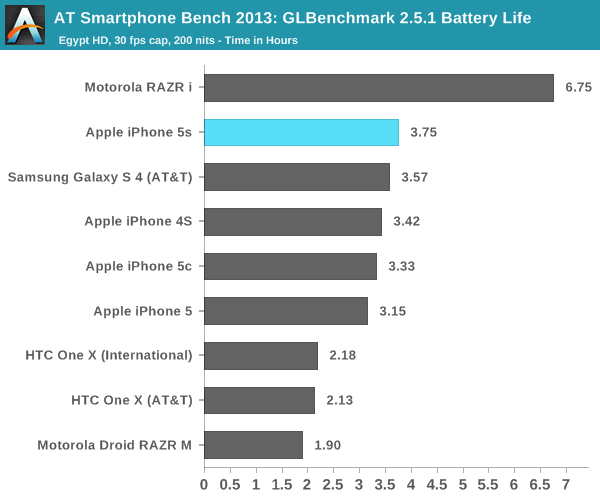The iPhone 5s Review
by Anand Lal Shimpi on September 17, 2013 9:01 PM EST- Posted in
- Smartphones
- Apple
- Mobile
- iPhone
- iPhone 5S
Battery Life
Brian did some excellent sleuthing and came across battery capacities for both the iPhone 5s and 5c in Apple’s FCC disclosures. The iPhone 5 had a 3.8V 5.45Wh battery, while the 5s boosts total capacity to 5.96Wh (an increase of 9.35%). The move to a 28nm process doesn’t come with all of the benefits of a full node shrink, and it’s likely not enough to completely offset the higher potential power draw of a much beefier SoC. Apple claims the same or better battery life on the 5s compared to the iPhone 5, in practice the answer is a bit more complicated.
Unlike previous designs, we’ve never had a half node shrink for an s-SKU. Both the iPhone 3GS and iPhone 4S stayed on the same process node as their predecessor and drove up performance. In the case of the 3GS, the performance gains outweighed their power cost, while in the case of the iPhone 4S we generally saw a regression.
The iPhone 5s improves power consumption by going to 28nm, but turns that savings into increased performance. The SoC also delivers a wider dynamic range of performance than we’ve ever seen from an Apple device. There’s as much CPU power here as the first 11-inch MacBook Air, and more GPU power than an iPad 4.
To find out the balance of power savings vs. additional performance I turned to our current battery life test suite, which we first introduced with the iPhone 5 review last year.
We'll start with our WiFi battery life test. As always, we regularly load web pages at a fixed interval until the battery dies (all displays are calibrated to 200 nits).

The iPhone 5s regresses a bit compared to the 5 in this test (~12% reduction despite the larger battery). We're loading web pages very aggressively here, likely keeping the A7 cores running at their most power hungry state. Even the 5c sees a bit of a regression compared to the 5, which makes me wonder if we're seeing some of the effects of an early iOS 7 release here.
The story on LTE is a bit different. Here we see a slight improvement in battery life compared to the iPhone 5, although the larger battery of the 5s doesn't seem to give it anything other than parity with the 5c:

Our cellular talk time test is almost entirely display and SoC independent, turning it mostly into a battery capacity test:

You can see the close grouping of the smaller iPhones at the bottom of the chart. There's a definite improvement in call time compared to the iPhone 5. We're finally up above iPhone 4S levels there.

Our Egypt HD based 3D battery life test gives us the first indication that Rogue, at least running fairly light code, can be more power efficient than the outgoing 5XT. Obviously the G6430 implemented here can run at fairly high performance levels, so I'm fully expecting peak power consumption to be worse but for more normal workloads there's no regression at all - a very good sign.










464 Comments
View All Comments
teiglin - Wednesday, September 18, 2013 - link
There is absolutely no basis to compare the process tech between A7 and Bay Trail. We know what battery life the A7 affords the iPhone 5s, but know nothing about what sort of battery life Silvermont might provide in a smartphone form factor. If those Oscar cores are really as power-efficient as Silvermont, then yes, that'd be amazing evidence of A7's power-efficiency.Wilco1 - Wednesday, September 18, 2013 - link
Given a 2.4GHz Bay Trail in a development board already cannot keep up with the A7 at 1.3GHz (A7 beats it by a huge margin on Geekbench), there is no hope for BT-based phones. BT would need to be clocked far lower to fit in a total phone TDP of ~2W, which means it loses out even worse on performance against A7, Krait and Cortex-A15.So yes, the fact that Bay Trail is already beaten by a phone before it is even for sale is a sign of things to come. 2014 will be a hard year for Intel given 20nm TSMC will give further performance and power efficiency gains to their competitors. It all starts to sound a lot like a repeat of the old Atom...
vcfan - Wednesday, September 18, 2013 - link
"Apple's designs are superior to Intel's. and then, Intel had better watch out."first of all, its arm vs x86. and second, it was "LOLz intel cant do low power chips,arm wins", now its "but but intel is 22nm" . hilarious.
ScienceNOW - Wednesday, September 18, 2013 - link
WE have plenty of time until 5nm, by that time most likely something New will be in place to pick up where silicone leftsolipsism - Tuesday, September 17, 2013 - link
Since when is a PS4 a desktop machine? And why only look at the GPU and not at the CPU that was clearly referenced?Crono - Tuesday, September 17, 2013 - link
Ha, I love the low-light image choice of subject. :DYou have to admit, it seems like Apple learned some things from Nokia and HTC this round to improve their cameras, though the combination dual flash is pretty ingenious. I'm wondering if the other manufacturers will adopt it or stick to single LED and Xenon flashes.
StevoLincolnite - Tuesday, September 17, 2013 - link
My Lumia has dual LED flashes, the Lumia 928 has dual Xenon flashes.So it's hardly anything new when the Lumia 920 has been on the shelf for almost a year.
whyso - Tuesday, September 17, 2013 - link
My HTC raider from 2011 has dual LED flash.Ewram - Wednesday, September 18, 2013 - link
my HTC Desire HD (HTC Ace) has dual led, bought it november 2010.melgross - Wednesday, September 18, 2013 - link
I think you missed the explanation of what Apple did here. The dual flashed in the past, and in yours and other current devices are just two flashes of exactly the same type. Apple's is one cold temp flash and one warm temp flash. The camera flashes before it takes the photo, then evaluates the picture quality based on color temperature. It then comes up with a combination of flash exposure that varies the amount each flash generates so as to give the proper color rendering, and well as the correct exposure.No other camera does that. Not even professional strobes can do that. I wonder if Apple patented the electronics and software used for the evaluation.